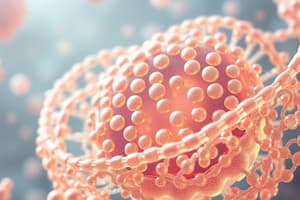Podcast
Questions and Answers
What are the major lipids found in cell membranes?
What are the major lipids found in cell membranes?
- Sphingolipids (correct)
- Sterols (correct)
- Phosphoglycerides (correct)
- Triglycerides
The lipid bilayer is essential for the life of the cell.
The lipid bilayer is essential for the life of the cell.
True (A)
What causes phospholipids to form bilayers spontaneously in aqueous environments?
What causes phospholipids to form bilayers spontaneously in aqueous environments?
Amphiphilic nature of phospholipids
Phospholipids contain a _____ head group and two _____ tails.
Phospholipids contain a _____ head group and two _____ tails.
What is the primary role of membrane proteins?
What is the primary role of membrane proteins?
What type of bond links fatty acids to glycerol in phospholipids?
What type of bond links fatty acids to glycerol in phospholipids?
Hydrophobic molecules dissolve readily in water.
Hydrophobic molecules dissolve readily in water.
What structural feature of sphingolipids distinguishes them from phosphoglycerides?
What structural feature of sphingolipids distinguishes them from phosphoglycerides?
The polar head of a phospholipid is typically composed of a _____ group.
The polar head of a phospholipid is typically composed of a _____ group.
Flashcards are hidden until you start studying
Study Notes
Cell Membrane
- Encloses the cell
- Defines cell boundaries
- Maintains differences between cytosol and extracellular environment
- Contains proteins that act as sensors for extracellular signals, leading to changes in cell behavior
- Cell membranes have common structures despite different functions
Lipid Bilayer
- Forms the basic structure of all cell membranes
- Contains approximately 50% of the mass in most animal cell membranes
- Bilayer structure is visible with electron microscopy
- Bilayer is attributable to the special properties of lipids
- Lipids naturally assemble into bilayers even in simple conditions
Phospholipids
- Are amphiphilic, containing both a hydrophilic (water-loving) and hydrophobic (water-fearing) portion
- They spontaneously form structured bilayers in aqueous environments
- The hydrophobic portion, comprised of two long, fatty acid tails, is directed towards the interior of the bilayer
- The hydrophilic head groups with their polar charges point towards the aqueous environment
- There are different variations of phospholipids due to different lipid compositions
Phosphoglycerides
- Are the most abundant membrane lipids
- Have a three-carbon glycerol backbone
- Two long-chain fatty acids link to adjacent carbon atoms on the glycerol backbone through ester bonds
- The third carbon atom of the glycerol connects to a phosphate group, which in turn attaches to a variety of head groups
- Numerous phosphoglycerides exist due to combinations of fatty acids and head groups
- The length and saturation of fatty acids impact how phospholipid molecules assemble, influencing membrane fluidity
Sphingolipids
- Built from sphingosine rather than glycerol
- Play important roles in various processes including signal transduction, stress responses, immune reactions, membrane structure, and brain development
Studying That Suits You
Use AI to generate personalized quizzes and flashcards to suit your learning preferences.




